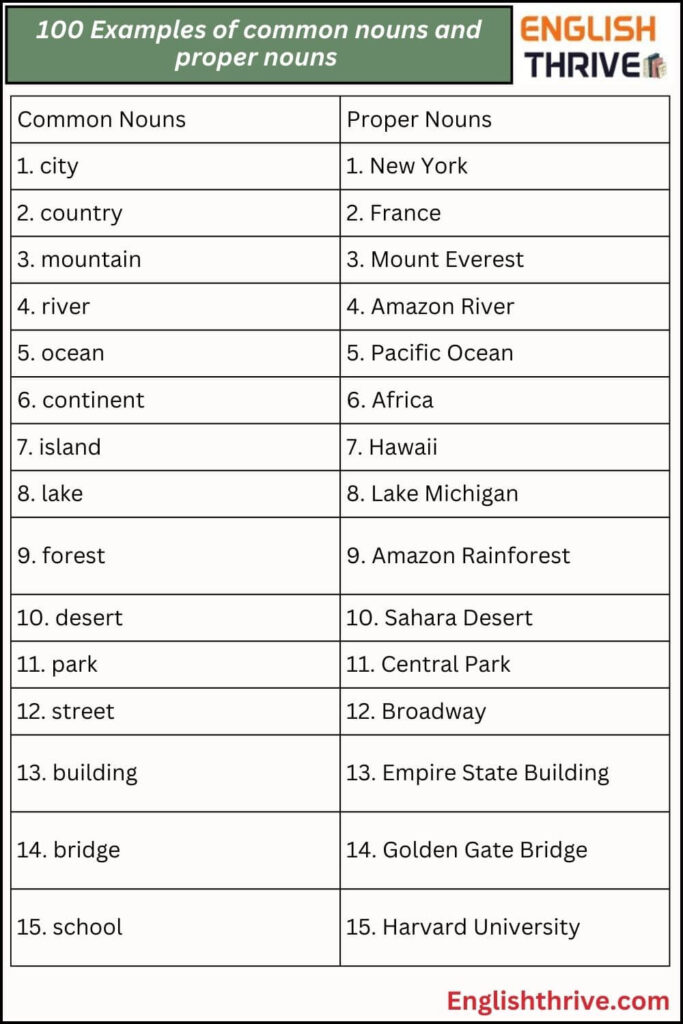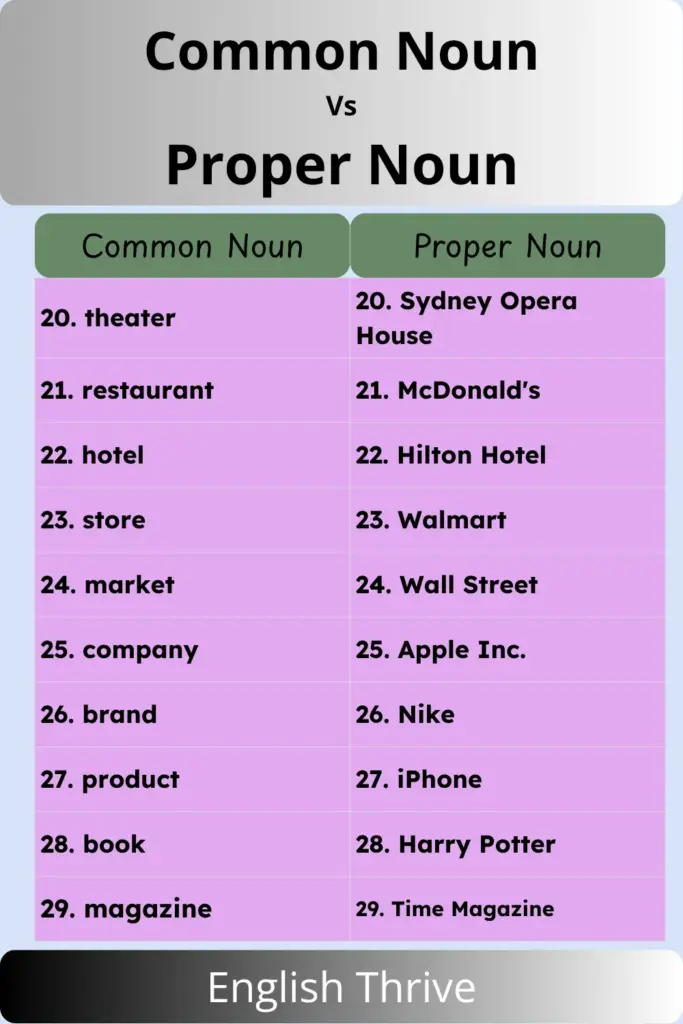Ever found yourself in a grammar pickle, wondering whether to use a common noun or proper noun? You’re not alone! Understanding these two types of nouns is like having a secret key to clearer communication. As someone who’s been there, I’ve gathered tips and tricks to make it easy. Let’s dive into the world of common noun and proper noun together and unlock the power of precise language. Ready to become a grammar pro? Let’s get started!
Contents
ToggleWhat is a Common Noun?
A common noun is a general name for a person, place, thing, or idea. These nouns are not capitalized unless they appear at the beginning of a sentence. Common nouns are used to refer to generic categories rather than specific entities.
Examples of Common Nouns:
- Person: teacher, doctor, student
- Place: city, park, beach
- Thing: book, car, phone
- Idea: love, happiness, freedom
What is a Proper Noun?
A proper noun, on the other hand, is a specific name for a particular person, place, thing, or idea. Proper nouns are always capitalized, regardless of their position in a sentence. They help us identify unique entities, making our communication more precise.
Examples of Proper Nouns:
- Person: Alice, John, Dr. Smith
- Place: New York, London, Mount Everest
- Thing: iPhone, Tesla, Mona Lisa
- Idea: Christianity, Buddhism, Democracy
The Importance of Distinguishing Between Common Noun and Proper Noun
Understanding the difference between common nouns and proper nouns is crucial for effective communication. It helps us convey our messages clearly and avoid confusion. For instance, if you’re talking about a general concept like “city,” you use a common noun. But if you’re referring to a specific city like “Paris,” you use a proper noun. This distinction ensures that your audience knows exactly what you’re talking about.
Practical Tips for Using Common Noun and Proper Noun
Now that we’ve established the basics, let’s explore some practical tips to help you use common and proper nouns effectively:
- Capitalization: Always capitalize proper nouns. This rule applies even when the proper noun is part of a compound word or a hyphenated term.
- Context Matters: Use common nouns when referring to general categories and proper nouns when referring to specific entities.
- Consistency: Be consistent in your use of nouns throughout your writing. This helps maintain clarity and coherence.
100 Examples of common nouns and proper nouns
| Common Nouns | Proper Nouns |
|---|---|
| 1. city | 1. New York |
| 2. country | 2. France |
| 3. mountain | 3. Mount Everest |
| 4. river | 4. Amazon River |
| 5. ocean | 5. Pacific Ocean |
| 6. continent | 6. Africa |
| 7. island | 7. Hawaii |
| 8. lake | 8. Lake Michigan |
| 9. forest | 9. Amazon Rainforest |
| 10. desert | 10. Sahara Desert |
| 11. park | 11. Central Park |
| 12. street | 12. Broadway |
| 13. building | 13. Empire State Building |
| 14. bridge | 14. Golden Gate Bridge |
| 15. school | 15. Harvard University |
| 16. hospital | 16. Mayo Clinic |
| 17. library | 17. Library of Congress |
| 18. museum | 18. Louvre Museum |
| 19. stadium | 19. Wembley Stadium |
| 20. theater | 20. Sydney Opera House |
| 21. restaurant | 21. McDonald’s |
| 22. hotel | 22. Hilton Hotel |
| 23. store | 23. Walmart |
| 24. market | 24. Wall Street |
| 25. company | 25. Apple Inc. |
| 26. brand | 26. Nike |
| 27. product | 27. iPhone |
| 28. book | 28. Harry Potter |
| 29. magazine | 29. Time Magazine |
| 30. newspaper | 30. The New York Times |
| 31. movie | 31. Titanic |
| 32. song | 32. Bohemian Rhapsody |
| 33. band | 33. The Beatles |
| 34. artist | 34. Leonardo da Vinci |
| 35. actor | 35. Tom Hanks |
| 36. director | 36. Steven Spielberg |
| 37. writer | 37. J.K. Rowling |
| 38. scientist | 38. Albert Einstein |
| 39. inventor | 39. Thomas Edison |
| 40. politician | 40. Barack Obama |
| 41. president | 41. Joe Biden |
| 42. king | 42. King Charles III |
| 43. queen | 43. Queen Elizabeth II |
| 44. prince | 44. Prince William |
| 45. princess | 45. Princess Diana |
| 46. hero | 46. Superman |
| 47. villain | 47. Darth Vader |
| 48. animal | 48. Tiger |
| 49. bird | 49. Eagle |
| 50. fish | 50. Nemo |
| 51. plant | 51. Rose |
| 52. tree | 52. Oak |
| 53. flower | 53. Sunflower |
| 54. fruit | 54. Apple |
| 55. vegetable | 55. Carrot |
| 56. food | 56. Pizza |
| 57. drink | 57. Coca-Cola |
| 58. car | 58. Tesla |
| 59. bike | 59. Harley-Davidson |
| 60. plane | 60. Boeing |
| 61. ship | 61. Titanic |
| 62. train | 62. Orient Express |
| 63. bus | 63. Greyhound |
| 64. sport | 64. Soccer |
| 65. game | 65. Chess |
| 66. team | 66. Manchester United |
| 67. player | 67. Lionel Messi |
| 68. coach | 68. Pep Guardiola |
| 69. event | 69. Olympics |
| 70. holiday | 70. Christmas |
| 71. festival | 71. Coachella |
| 72. language | 72. Spanish |
| 73. religion | 73. Islam |
| 74. culture | 74. Japanese |
| 75. tradition | 75. Thanksgiving |
| 76. art | 76. Mona Lisa |
| 77. music | 77. Jazz |
| 78. dance | 78. Ballet |
| 79. instrument | 79. Piano |
| 80. tool | 80. Hammer |
| 81. machine | 81. Robot |
| 82. device | 82. Smartphone |
| 83. software | 83. Microsoft Word |
| 84. app | 84. Instagram |
| 85. website | 85. Google |
| 86. social media | 86. Facebook |
| 87. technology | 87. Artificial Intelligence |
| 88. science | 88. Physics |
| 89. math | 89. Algebra |
| 90. history | 90. Renaissance |
| 91. geography | 91. Himalayas |
| 92. economy | 92. Capitalism |
| 93. politics | 93. Democracy |
| 94. law | 94. Constitution |
| 95. education | 95. University |
| 96. health | 96. Medicine |
| 97. environment | 97. Climate Change |
| 98. society | 98. Community |
| 99. family | 99. Smith Family |
| 100. friend | 100. John |
Diving Deeper into Common Noun and Proper Noun
Now that we have a solid foundation, let’s explore common and proper nouns in more detail. Understanding their nuances will help you use them more effectively in your writing and conversations.
Common Nouns: The Everyday Heroes
Common nouns are the workhorses of our language. They help us talk about everyday things without getting too specific. Here are some key points to remember about common nouns:
- Generic Terms: Common nouns refer to general categories. For example, “dog” is a common noun that refers to any dog, not a specific one.
- Not Capitalized: Common nouns are typically not capitalized unless they appear at the beginning of a sentence.
- Plural Forms: Most common nouns can be made plural by adding “s” or “es.” For example, “cat” becomes “cats,” and “box” becomes “boxes.”
Examples of Common Nouns in Sentences:
- I love reading books in the park.
- The doctor advised me to take medicine.
- Children play in the garden.
Proper Nouns: The Specific Stars
Proper nouns, on the other hand, are the stars of our language. They help us identify specific entities, making our communication more precise and personal. Here are some key points about proper nouns:
- Specific Names: Proper nouns refer to particular people, places, things, or ideas. For example, “Michael” is a proper noun that refers to a specific person named Michael.
- Always Capitalized: Proper nouns are always capitalized, regardless of their position in a sentence.
- Unique Identifiers: Proper nouns help us distinguish one entity from another. For example, “Paris” refers to a specific city, not just any city.
Examples of Proper Nouns in Sentences:
- Alice went to New York for a vacation.
- Dr. Smith is a renowned surgeon.
- The Eiffel Tower is a famous landmark in Paris.
Exceptions and Special Cases
While the rules for common and proper nouns are generally straightforward, there are some exceptions and special cases to be aware of:
- Brand Names: Some brand names start as proper nouns but become so widely used that they are treated as common nouns. For example, “Kleenex” is a brand name, but it’s often used to refer to any tissue.
- Geographical Names: Names of geographical features like mountains, rivers, and oceans are proper nouns. For example, the “Amazon River” and “Mount Everest.”
- Historical Events: Names of historical events and periods are proper nouns. For example, “World War II” and the “Renaissance.”
Table of Common Noun and Proper Noun
To help you better understand the differences, here’s a table with examples of common and proper nouns:
| Category | Common Noun Examples | Proper Noun Examples |
|---|---|---|
| Person | teacher, doctor | Alice, Dr. Smith |
| Place | city, park | New York, London |
| Thing | book, car | iPhone, Tesla |
| Idea | love, happiness | Christianity, Democracy |
| Brand | tissue, soda | Kleenex, Coca-Cola |
| Event | war, festival | World War II, Olympics |
Practical Exercises
To solidify your understanding, try these practical exercises:
- Identify Nouns: In a paragraph, identify all the common and proper nouns.
- Rewrite Sentences: Rewrite sentences by changing common nouns to proper nouns and vice versa.
- Create Stories: Write short stories using a mix of common and proper nouns to practice their usage.
Conclusion about Common Noun and Proper Noun
Mastering common noun and proper nouns is a fundamental step in improving your English language skills. By understanding the differences and applying the rules consistently, you’ll enhance your communication and writing abilities. Keep practicing, stay curious, and enjoy the journey of learning!



